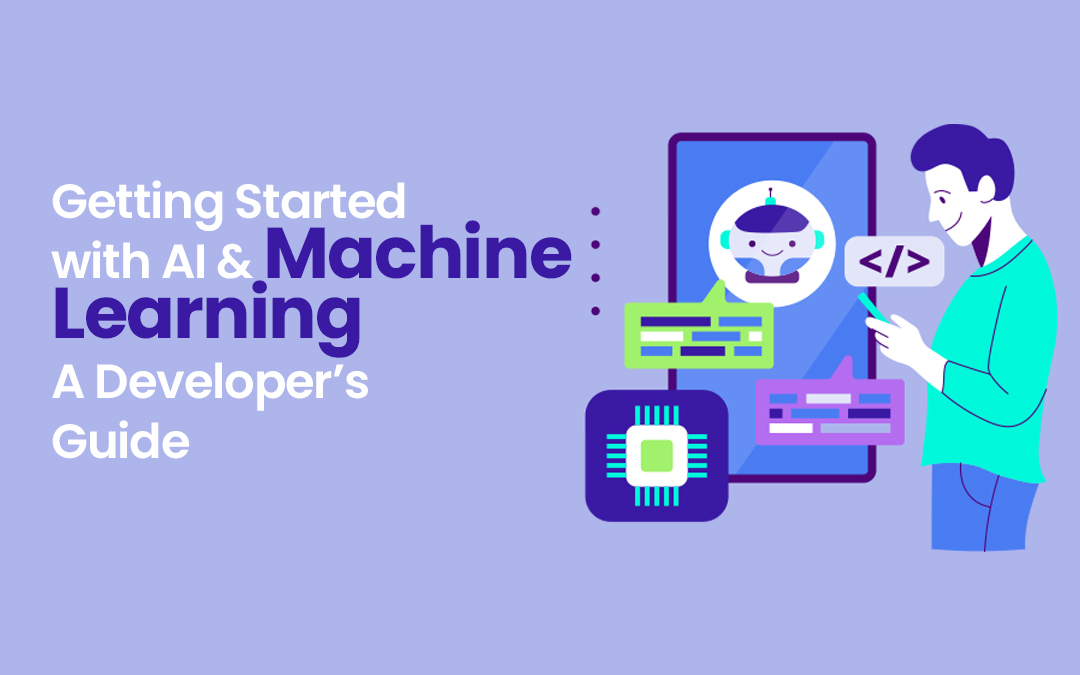
Industries have been transformed from artificial intelligence (AI) to machine learning (ML), and their processes have been automated while giving actionable insights and intelligent applications. Applying a chatbot engine or a recommendation system through a fraud detection system will have endless potential applications.
Investing in such an AI-powered solution is essential to gain a competitive advantage in any business. This is usually done by hiring AI ML developers or machine learning developers who will focus on the project and build scalable, intelligent applications.
This is a thorough guide to understanding the basic concepts of AI and ML, the skill set that defines a developer, and how to kick-start your journey into AI ML development.
Core Concepts of AI, ML, and Deep Learning
Well, before the practical exposure comes in, it is important to have the core concepts that hold AI and ML under attention:
Artificial Intelligence (AI):
The very definition of AI is the simulation of human intelligence onto machines so that the machines may perform tasks for which human cognition- such as reasoning, learning, and decision-making- is usually required.
Machine Learning (ML):
A subfield of AI, ML deals with the making of algorithms that facilitate machine learning from data instead of requiring it to be explicitly programmed. Performance improvement through experience is one of its highlights.
Deep Learning (DL):
DL is an exclusive field of ML that uses multiple layers of artificial neural networks (that is, deep neural networks) to analyze and extract insightful data from complex patterns of information.
Why Invest in ML and AI?
- Better Decision-Making: AI algorithms scan big data to give actionable recommendations.
- Automation: AI automates routine work, minimizing manual intervention.
- Personalization: Recommendation systems give customized customer experiences.
- Anomaly Detection: Banks use AI to detect unusual patterns.
- Predictive Analytics: AI algorithms predict future trends based on past behavior.
Nowadays, companies want to hire ML developers with expertise in creating AI applications that give real-time insights in order to stay competitive.

Essential Skills for AI and ML Developers
If you’re planning to hire dedicated machine learning developers, ensure they possess these key skills:
- Programming Languages: Knowledge of one or more important programming languages, such as Python, R or Java, concerning AI and ML projects.
- Mathematics and Statistics: Thorough knowledge of Linear Algebra, Probability Theory and Statistics.
- Data Handling: Experience in handling data preprocessing, cleaning, and using computational libraries such as Pandas and NumPy.
- Machine Learning Environment: Familiar with environments such as Tensorflow, Pytorch, Scikit-learn, etc.
- Data Visualization: An interpretive power to design the data with visually aided libraries such as Matplotlib, Seaborn, etc.
- Problem-solving: These are developers who should apply a problem-solving attitude to develop scalable AI solutions.
Key Libraries and Frameworks for AI/ML Development
- NumPy: The primary core library for numerical computation in Python as well, with support for arrays, matrices, and mathematical operations.
- Pandas: The most powerful library in data analysis and manipulation, is made of data structures such as DataFrames and Series, for fast processing of the required data.
- Scikit-learn: Complete machine learning library that offers a pull of classification, regression, clustering, and dimensionality reduction algorithms.
- TensorFlow: This open-source machine learning system is also created by Google and is used extensively for deep learning model building and training.
- Keras: The deep learning high-level neural networks API that simplifies deep learning a lot to develop with an easily comprehensible interface in training and building networks.
Step-by-Step Guide to Getting Started with AI and ML
Follow these practical steps to kickstart your AI and ML journey:
Understand the Problem
Clearly understand which problem you are seeking to solve before developing your AI model. Whether one is predicting customer behavior, anomaly detection, or process automation, enunciating the goal is critical.
Collect and Clean Data
Data is the foundation of any AI system. Collect relevant data, clean it, and preprocess it to make it of good quality. Data cleaning is done by dealing with missing values, deleting duplicates, and normalizing formats.
Select the Appropriate Tools and Libraries
Some of the most widely used libraries for AI and ML development are:
- TensorFlow and PyTorch for neural network building.
- Scikit-Learn for conventional machine learning algorithms.
- Keras for easy deep-learning models.
Train and Test the Model
Split your data into training and test sets. Train the model with training data and test its performance with the test data. Methods such as cross-validation assist in accuracy.
Optimize and Fine-Tune
Following training, hyperparameters are fine-tuned to optimize model performance. Techniques such as Grid Search or Random Search can be used to optimize hyperparameters.
Deploy the Model
Implement your AI model on cloud platforms such as AWS, Azure, or Google Cloud. APIs or containerization via Docker and Kubernetes will help make your models available across applications.
If your company lacks the technical capabilities to perform these actions, it is advisable to employ committed machine learning developers to implement them effortlessly.
Practical Steps to Consider When Starting AI/ML Projects
- Start With Simple Projects: The best starting point would be beginner-oriented projects, such as implementing linear regression or classifying images using a pre-trained model.
- Experiment With Datasets: Make use of publicly available datasets from sites like Kaggle or the UCI Machine Learning Repository to test your skills.
- Experiment With Various Algorithms: Work on the same dataset with different ML algorithms, compare results, and learn about their respective merits and demerits.
- Prepare a Portfolio: Prepare an array of the projects completed to reflect your skills and experience to prospective employers.
- Participate in Open Source Projects: Participate in open-source AI/ML projects for experience and collaboration with other developers.
Common AI and ML Applications Across Sectors
AI and ML are used across sectors for various use cases. Let's discuss some:
- E-commerce: Product recommendation based on AI algorithms.
- Healthcare: Predictive analysis to diagnose diseases in advance.
- Finance: Detection of fraud using anomaly detection models.
- Marketing: AI-based chatbots to improve customer support.
- Manufacturing: Predictive maintenance using machine learning algorithms.
Companies typically hire AI ML developers to develop sector-specific solutions that improve efficiency.
Conclusion
AI and machine learning rule the whole digital world by making data-driven insights and intelligent automation accessible for business houses. They have applications from predictive analytics to personalizing the customer experience, by which companies get an advantage against the competition.
Developing applications in AI is very important to hire AI ML developers or set up an AI model in big corporate houses to optimize business processes. Depending on whether you choose to hire AI ML developers or hire dedicated machine learning developers, you can ensure the successful development and deployment of these intelligent solutions.
Share this post
Leave a comment
All comments are moderated. Spammy and bot submitted comments are deleted. Please submit the comments that are helpful to others, and we'll approve your comments. A comment that includes outbound link will only be approved if the content is relevant to the topic, and has some value to our readers.

Comments (0)
No comment